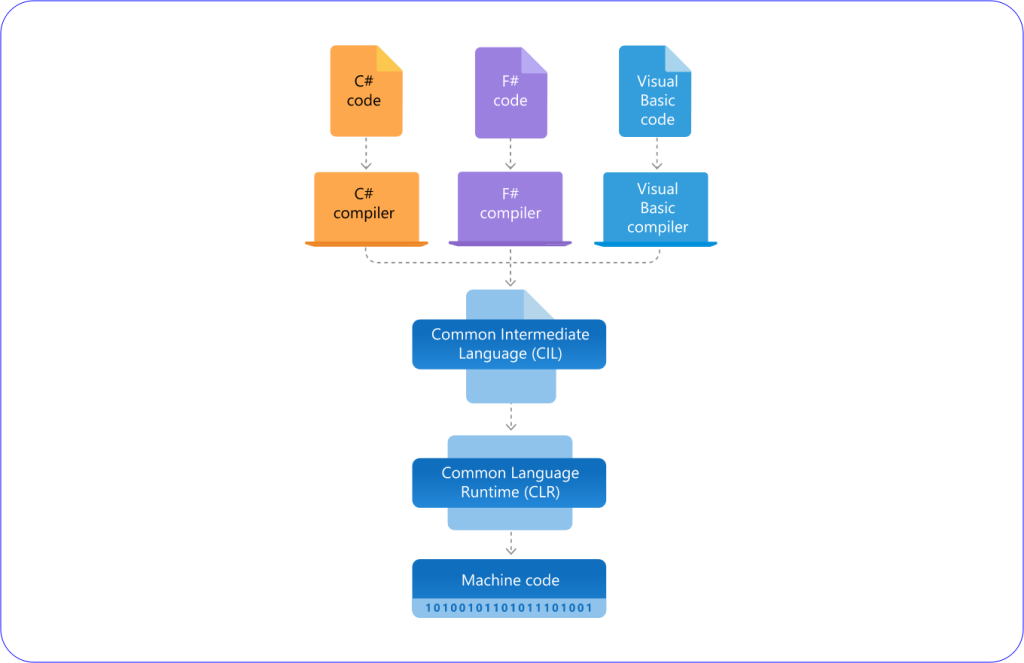The .NET Framework is a Microsoft platform used to create Windows applications. It includes various tools, programming languages, and libraries for building desktop and web apps, websites, web services, and games.
The .NET Framework was designed for building Windows applications and was first released in 2002 as .NET Framework 1.0. Over time, it has evolved, and the latest version is .NET Framework 4.7.2 by Microsoft.
With the Microsoft .NET Framework, developers can build both Form-based and Web-based applications, and it also enables the creation of web services.
The .NET Framework supports different programming languages like Visual Basic and C#, giving developers the flexibility to choose the language they prefer for building their applications.
.NET vs .NET Framework: What’s The Difference?
.NET is an open-source platform with various programming languages, libraries, and tools to build applications. The .NET Framework is a part of this platform and allows running .NET applications on Windows.
In simple terms, .NET is a development platform, and the .NET Framework is a support system for applications built with .NET.
Components of The .NET Framework
The following are the key components of the .NET Framework:
- Common Language Runtime (CLR)
- Class Library
- Languages
Common Language Runtime (CLR)
The Common Language Runtime (CLR) is the core execution environment of the .NET Framework. It is responsible for running .NET applications and managing their execution.
Some key features of the CLR include:
- Language Independence: The CLR allows .NET applications to be written in different programming languages, such as C#, VB.NET, F#, and more. It achieves this by compiling the source code of each language into a common intermediate language (IL) code, also known as Microsoft Intermediate Language (MSIL).
- Just-In-Time (JIT) Compilation: When a .NET application is executed, the CLR translates the IL code into machine code specific to the target platform using a process called JIT compilation. This enables the application to take advantage of the performance optimizations provided by the native machine code.
- Memory Management: CLR provides automatic memory management through garbage collection. It automatically deallocates memory that is no longer in use, freeing developers from manual memory management and helping to prevent memory leaks.
- Exception Handling: The CLR handles exceptions, which are errors or abnormal conditions that occur during the execution of a program. It provides a structured mechanism for catching and handling these exceptions, improving the robustness of .NET applications.
Class Library
The Class Library in the Dotnet Framework is a collection of pre-built and reusable classes, interfaces, and value types that provide a wide range of functionalities.
Key aspects of the Class Library include:
- Namespaces: The classes in the Class Library are organized into logical groups called namespaces (e.g., System.IO, System.Net, System.Data). Namespaces help in categorizing and accessing related classes.
- Abstraction and Encapsulation: The Class Library abstracts complex operations and encapsulates functionality, providing developers with simplified interfaces to perform tasks such as file I/O, network communication, database access, and more.
- Extensibility: Developers can create their own class libraries and extend the existing ones to build custom solutions tailored to specific application requirements.
Supported Languages and Application Types
The Dotnet Framework supports various programming languages and allows developers to create different types of applications:

- WinForms: WinForms (Windows Forms) is a technology used to build desktop applications with graphical user interfaces. These applications run on end-user machines and provide a standalone user experience. Examples of WinForms applications include text editors, media players, and productivity tools.
- ASP.NET: ASP.NET is used for building web-based applications. These applications run on web servers and interact with clients through web browsers like Chrome, Firefox, or Internet Explorer. ASP.NET applications are processed on the server side, and the results are sent to the clients’ browsers for display.
- ADO.NET: ADO.NET is a technology used for data access in .NET applications. It provides classes and methods to interact with databases, making managing and manipulating data easier.
Unlike Django, which mainly focuses on web applications, the .NET Framework offers a broader range of possibilities. It allows us to build various types of applications, including web apps, APIs, desktop applications, and database applications, among others. Its versatility makes it suitable for a wide array of development needs.
Pros and Cons of The .NET Framework
| Pros | Cons |
|---|---|
| Extensive Libraries: Saves time for developers. | Some tools and elements can be costly. |
| Works with all languages: Common Type System. | Beginners may find it challenging to learn. |
| Automatic Memory Management via CLR. | Limited Cross-Platform Support: Full framework is Windows-only. |
| Applications need minimal changes for Compatibility. | Dependency on Windows: Certain features may be Windows-specific. |
| All-encompassing: Supports various types of apps. | Need for Frequent Updates: Regular updates are required for security. |
| Tight Integration with Windows. | Applications may have larger file sizes. |
| Cross-Platform Support with .NET Core. | Some services and tools are Microsoft-centric. |
FAQs about .NET Framework
What can I build using .NET Framework?
You can build a wide range of applications, including web apps, desktop applications, APIs, mobile apps (using Xamarin), and more.
Is .NET Framework open-source?
No, the .NET Framework was initially a closed-source framework. However, with the introduction of .NET Core, which is open-source, Microsoft shifted focus to .NET 5 and beyond, merging .NET Core and .NET Framework codebases into .NET.
What is the difference between .NET Framework and .NET Core?
.NET Framework is primarily for Windows and supports various application types. .NET Core is cross-platform, open-source, and supports web, desktop, and cloud applications.
Is .NET Framework the same as ASP.NET?
No, ASP.NET is a subset of the .NET Framework, focused specifically on building web applications and services.
Does .NET Framework work on non-Windows platforms?
The full .NET Framework is limited to Windows. However, .NET Core and the latest .NET 5+ are cross-platform and work on Windows, macOS, and Linux.
Can I migrate my existing applications to .NET Core or .NET 5+?
Yes, Microsoft provides tools and documentation to help with the migration process, but some changes may be required due to platform differences.
Can I use any programming language with .NET Framework?
.NET Framework supports various programming languages, including C#, VB.NET, F#, and more, allowing developers to choose their preferred language.
What is the difference between .NET Framework and .NET Standard?
.NET Framework is a specific implementation for Windows, while .NET Standard is a specification that defines APIs that should be available on all .NET platforms.
Is .NET Core backward compatible with .NET Framework?
While .NET Core and .NET Framework have many similarities, they are not fully backward compatible due to platform-specific differences.
Can I use .NET Framework to develop games?
Yes, you can develop games using .NET Framework with libraries like MonoGame or Unity.
Is .NET Framework suitable for enterprise-level applications?
Yes, .NET Framework is widely used for building enterprise-level applications due to its robustness, scalability, and extensive libraries.
